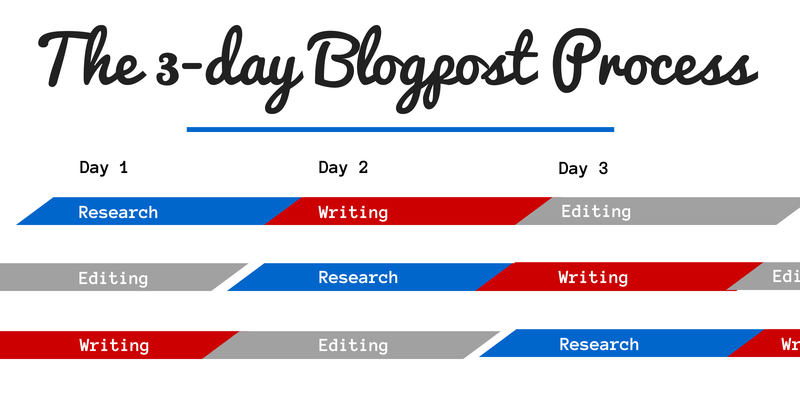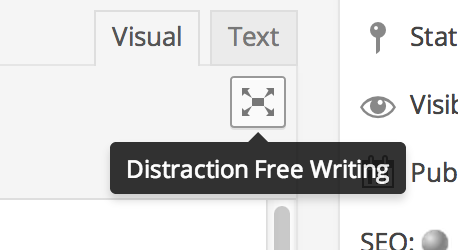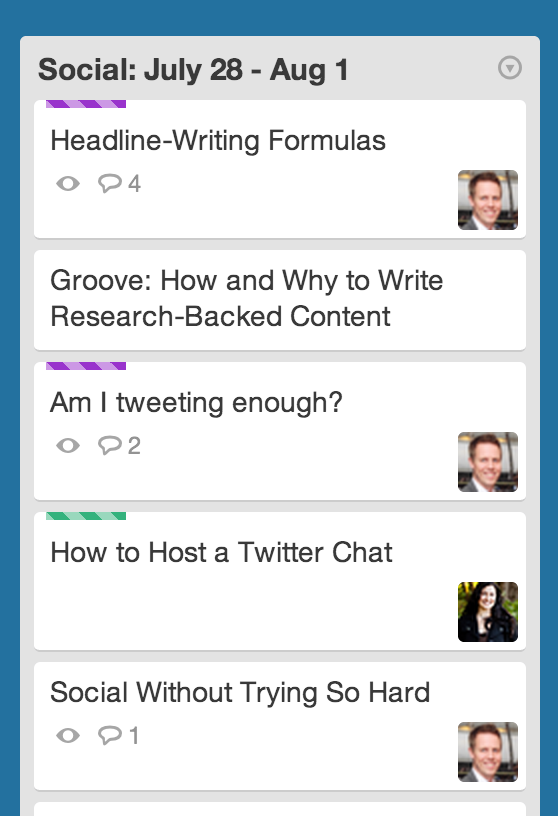If you put 100 bloggers in a room, odds are that only five of them are writing blog posts of 1,500 words or more.
At Buffer, we are one of those five.
And as Buffer’s content crafter, I have the joy and privilege of contributing to this content explosion—1,500 words per post, four posts per week, for a grand total of 6,000 words in one week’s time.
How do we do it?
Let’s start with why we do it.
Why Buffer Creates So Much Content So Quickly
Not only do we write four or more 1,500-word posts per week, each post also takes six or more hours to complete, and we create at least one unique visual per post, which again would put us in the vast minority of typical bloggers. What’s our deal? Well, you can think of it in a couple neat ways. First, we’ve found great results in research-backed, in-depth articles on social media marketing. Here are a couple examples:
- In the first year or more of Buffer, 100% of acquisition was done via content marketing.
- We’ve gained publishing partnerships with sites like Time and Fast Company.
Second—and this one’s an interesting one—Garrett Moon of CoSchedule suggests that perhaps we’ve stumbled upon a Blue Ocean Strategy with the in-depth, well-researched, long blog posts that we churn out on a near-daily basis. When few others are doing the same, you enjoy a bit of a monopoly on this type of craveable content.
Of course, the content still needs to be written.
That’s where our content team comes in to play. I’ll be happy to share below about our writing process and our organization structure, i.e. how the h-e-double-hockey-sticks we create as much content as we do. I’d love to hear how you get your writing done, too!
The Buffer team of millions, just kidding, there are two of us
The Buffer content team consists of Courtney (our Head of Content Marketing) and me (Content Crafter extraordinaire). I added the extraordinaire part. (Editors Note: We agree, though)
That’s it. There are two of us.
For what it’s worth, we have one bonus person than the content team used to have. Before Courtney and I joined earlier this year, Belle Beth Cooper wrote the lion’s share of content for the blog with an assist from our co-founder Leo. Before that, Leo did it all himself.
(Of note: Belle wrote amazing posts in four hours flat. Seriously.)
In terms of raw output, we’ve honed our schedule to a pretty standard four posts per week.
I write three posts.
Courtney (amid her multiple other content duties) takes one post, either something she writes herself or a guest post contribution that she manages and edits.
We’re also fortunate to have our Community Champion Nicole put together a weekly recap of our Twitter chats.
The schedule typically sorts itself out to something like this:
How the Hell Buffer Creates So Much Content So Quickly by @kevanlee
Monday: Kevan
Tuesday: Courtney / guest blog
Wednesday: Kevan
Thursday a.m.: Kevan
Thursday p.m.: Nicole
We have another blog, too. Our Buffer: Open blog covers productivity and life hacking, as well as all things Buffer culture and transparency. We post at least four times per week on the Open blog as well. I write one in-depth post about life hacking, Courtney takes the other three. She often grabs from our YouTube channel, our weekly improvements list, and republished articles from our teammates’ personal blogs.
How we/I create as much content as we/I do – The philosophical reasons
I imagine you’re after the specific, concrete tips for how we create our heap of content each week. No worries, that part’s coming.
But before I get there, I think it’s helpful to explain the way I think about creating content and structuring my time. It’s the boring, ephemeral stuff, I know! But a bananas-amount of content has to start with a good foundation.
1. Make content a priority
This starts at the top with Buffer’s co-founders Leo and Joel. They’ve chosen to invest in content by devoting a single person to do one thing extraordinarily well: write. I’m blessed to be that person (and I’m working hard on the “extraordinarily well” part).
2. Be ruthless about your time
You’ve probably heard the phrase: “Beyonce gets 24 hours in her day just like everyone else.” The point is that we all get the same amount of time, and it’s up to us to choose the best way to spend it. When I sit down to write, that is the only thing I do. No email. No Tumblr. No RSS reading for “research.” No listening to music. I open a new browser window and write until I’m done.
“A bananas-amount of content has to start with a good foundation.” @kevanlee
3. Focus on your one big thing
When I first started out in blogging, one of the best pieces of advice I heard came from Darren Rowse. It went something like this: “Find the most important things you MUST do. Do those things first. Do other things later or not at all.” At the time, this meant write like a madman and maybe not check analytics for a week or two. At Buffer, this might mean write like a madman and let a few Twitter conversations wait a couple hours or a couple days.
4. Give your writing the time it needs
How long does it take for me to write a blog post? However long the blog post wants.
That’s a total cop-out answer, by the way. A blog post will typically take me six to eight hours of writing, percolating, editing, and stylizing. That being said, each blog post differs wildly. Some come together like magic, and I’m outta there in three hours tops. Others are like Pilgrim’s Progress; twelve hours and four iterations later, I maybe have something I’m okay showing to others.
The point is that I’m not rigid with my writing. I allow for some flexibility and for the blog post to take as much time as it needs until it’s right.
Literally how I do what I do – The schedule and tools for writing so much content so quickly
OK, enough happy talk. Here are the nuts and bolts of writing 6,000 words each week.
Wake up at 5:30 a.m. to write
You may not have to do this. I have to do this. I find that I’m at my most creative and most productive in the early morning hours when the world is snoring and I don’t have the social pressure to be in HipChat or replying to email. I get more done when I’m not expected to be anywhere else. No one really expects you anywhere other than in bed at 5:30 a.m.
Split each blog post into a three-day routine
I once equated writing a blog post from start to finish in a single session with painting a mural that is never more than three feet away from your face. I’m not sure that’s 100% accurate, but you get the gist. Good content needs time to breathe, and a good writer uses time to reflect. Interestingly enough, our subconscious minds keep turning ideas over and over even when we’re not working on them directly. In this sense, a blog post improves when you’re not even writing it.
Here’s how my blog posts percolate.
Day one: Research
I collect everything I can find on the chosen topic, copy all the quotes and sources into the WordPress editor, and organize it all into an outline.
Day two: Writing
“Good content needs time to breathe, and a good writer uses time to reflect.” @kevanlee
I write with no judgment. I write terrible first drafts. I put down on paper paragraphs so heinous I can barely stand the thought of reading them the next day. But you know what? It takes away the terror of the blank page. Having something terrible is better than having nothing at all.
The Day Two writing process also includes things like choosing a featured image and noting which types of graphics might be handy. Basically, the goal is to have the post completely written and thought-out, just in need of a fine-toothed comb.
Day three: Editing
The fine-toothed comb! Depending on the state of the previous day’s writing, editing might not take much time at all. I’m hoping at this stage to be able to read through the post with an objective eye. I’ll cut out anything extra (usually lots). I’ll create some images in Canva. I’ll find that the terrible paragraphs I wrote the day before actually weren’t that terrible after all.
Stagger the three-day process
Here’s perhaps the biggest step to creating so much content: You have to stagger the schedule.
Each day on the calendar, I’m researching a new post, writing a different post, and editing still a different one. That’s three unique posts that I touch on any given day, and each post is in a different part of the process. It’s the best way I’ve found to ship something new every day and still have something ready to ship tomorrow.
Write in the distraction-free WordPress editor
If you’re anything like me, you get distracted easily. And there’s a lot to distract me in a WYSIWIG editor.
That’s why I use the distraction-free WordPress editor. It’s a full-screen view of your words and only your words. You can get some very basic editing buttons if you mouseover the top of the post, but other than, it’s all Arial on white. To use it, click the four-way arrow icon in the upper-right corner of the WordPress editor.
(Pro tip: You can change the width of the editor screen by pressing CTRL+(plus) or CTRL+(minus). I’ve got mine as skinny as our main blog content area.)
Use Skitch for screen grabs
You can use whatever you want. I use Skitch or, when I’m really flying, I forget to use Skitch and just use the Mac keyboard shortcut.
Take good notes
We have a running tab of ideas in a shared Trello board. These ideas get moved from General List > Week Of where they’ll enjoy a brief moment in the sun before I write them up. The good part about these Trello cards is that we can add any random links or sources we happen to find during our normal curation, and then all that great info is there for me to grab when I sit down for Day One Research!
Get really good at Google searches
Search deep, search fast. I like to add “AND research” to my search terms to see what kind of research or data is out there. Also, I get a lot of use out of “site:” when I’m hunting down a particular topic and I think a favorite website might have covered it before. (If there were a single hotkey for “site:blog.kissmetrics.com,” I’d be in heaven.)
Send random thoughts into a notebook
I am not immune to the distraction of random thoughts. They’re not bad, per se. Sometimes I picture writing a blog post like driving a car at 100 miles per hour. Even the slightest bump of the steering wheel (e.g. a thought about another project) will drastically throw me off course.
When random thoughts do pop up, they go straight into a notebook so my mind can be freed. I review the notebook lists often, and in the meantime, my mind is clear to write.
How Buffer writes so much content
Remember how I said we like to write in-depth, well-researched blog posts that last longer than 1,500 words? This one here is over 2,000 words! So in case I lost you halfway through, here’s the bird’s eye view.
- Place a priority on content and allow yourself to write like mad.
- Cut out everything that doesn’t matter. Be ruthless with your time.
- Come up with a schedule. Take my three-day routine, free of charge. Guaranteed results or your money back.
- Minimize distractions with a WordPress editor or a notebook.
- Always be thinking about content. Save everything you find; it’ll save minutes off a blog post. Minutes add up.
If I could add one final point: Learn from others! I recently read a post from Neil Patel about how he produces blog posts in—you might want to be sitting down when you read this—45 minutes! I’m going to try his tactics, too. You can follow along with my progress at the Buffer blog, if you’d like.
Speaking of learning from others, how do you do what you do? I’d love to hear your take on content creation in the comments.
Want a Short-Cut?
Try Kapost’s template for writing blog posts and get your content out there even faster!





